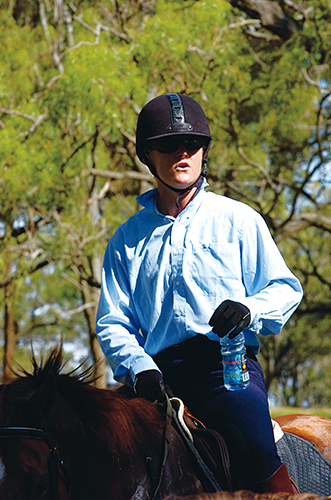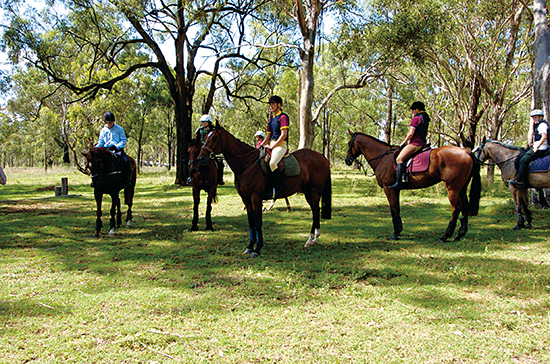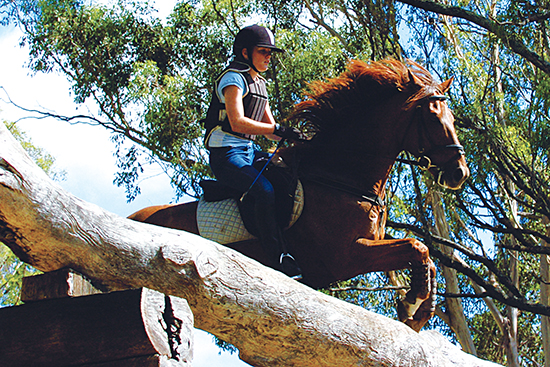 Story by Chris Hector & Photos by Roz Neave
Story by Chris Hector & Photos by Roz Neave
One of the many wonderful things about the recent Warwick Summer Eventing School was the chance for Queensland riders to learn from fellow Queenslanders who have made it to the top – and no one has made it more spectacularly than Rebel Morrow – Australia’s eventing hero at the last Olympic Games.
Reb is nothing if not direct, and she is a no-nonsense instructor as she takes her little band over the brush and ditch: “Want to sit there chattering, great but if you want to start him cold, you have to wake him up before you get him to the jump. Hands down, leg on, if you get him deep, don’t just drop him, keep your leg on and give him a confident jump. Soften the front end off a little, you were pulling him up in front of the fence.”
And there was no slacking after the fence:
“Pick him up, don’t let him go on the forehand after the fence. Do a bit more on landing and get him up straight away. Work in there, get him up and make him carry himself.”
Time to move on to the Suspended Log:
“A suspended log uphill is one of those fences you can’t under-ride. Hold on to a bit of mane, be positive. This is never going to be a pretty jump, you need extra strong leg, extra strong position, and you can’t pull back at all. Sit up tall and come in very defensive, use your voice, use whatever you’ve got.”
“If your leg comes off for even one second, then even the best horse can stop – they can’t see what is on the other side. GET your lower leg on, I can already see daylight between your lower leg and the horse. Be easy on him at the point of departure, he needs to be confident of you in his mouth, use a little half halt but don’t be severe. GOWARN do it again – I think you sat a bit pretty…”
Later, I had the opportunity of discussing this all important lower leg position with Rebel, who as readers probably know, showed in the publication The Athens Dream that her limbs are not just effective but also spectacular to look at…
What is the secret of establishing a good firm, secure seat?
“The way to establish it is to have your heels very deep and your lower leg slightly forward, so that you have got your lower leg closed around the horse and your knee off the saddle: that’s the cement, that’s the basis of your good position. Then it is a matter of being able to sit softly in the saddle, with your shoulders up tall, so your upper body uses strength through your shoulders and your back.”
Sounds great but how do you get your body to do it?
“At first it feels very uncomfortable to get your leg forward until you get used to it. They’ve got to keep going out of their comfort zone to get it forward there. Once they realise how beneficial it is to have your lower leg forward with your heel down, they’ll force themselves to do it more. I guess until they have had a scare where their upper body has gone forward, and their lower body has gone back, they don’t realise the benefit of that strong lower leg position. Sit up tall, relax the arms, relax your elbows, and you can lengthen the rein like that, instead of shooting your body too far forward.”
“Especially for young horses, and young riders, until you are experienced like Stuart Tinney, and can maintain a forward seat, the defensive seat is the far safer alternative. I ride quite defensively; it is very rare that I get forward because I don’t want to be caught out. I sit slightly back, and soft in the saddle.”
Who taught you this riding technique?
“I guess because I have ridden all sorts of horses. I haven’t been able to just sit on horses that go for you, I’ve ridden all sorts, and I’ve adopted that position. I watch other riders; I see where Matt Ryan’s legs are – and where Stuart Tinney has his. Matt’s lower leg is way more forward, and that’s his special technique – my legs do shoot forward in extreme circumstances, but I am not as defensive as Matt. I sit up taller; I guess that’s partly my showjumping training with Simone Kann and Michelle Lang. I feel quite confident to sit up, sitting soft in the saddle, not heavy on the horse’s back, and use the strength in my legs to balance the weight in my body. I don’t land on their back heavily. I guess my position comes from riding green horses because I don’t want to let them have a scare. I want to be very strong in my legs so I don’t fall back on them, or pull on their mouth. I am always ready for when they spook when they go cross country, they are always likely to spook sideways, and I want to be ready for it.”
This is one of the ugliest things you see – riders hitting the poor horse in the mouth, then getting after him because he has reacted?
“I encourage riders to grab the mane with one hand. I will grab the mane. If I am not sitting very well to the horse’s jump, I’ll hold the mane. There is nothing belittling about doing that. You are maintaining your position, you are keeping your horse confident – grab the mane, do what you have to do.”
Learning cross-country riding skills – is that just a matter of putting in the miles?
“Yeah, like go to somewhere like the Warwick School and have two lessons a day with some really top instructors. We all pretty much repeat the same thing, and then it becomes cemented in your mind. It becomes normal. I don’t have to think about that sort of thing any more – you just DO IT, because you’ve had it drilled into you.”
A suspended log uphill is one of those fences you can’t under-ride. Hold on to a bit of mane, be positive. This is never going to be a pretty jump, you need extra strong leg, extra strong position, and you can’t pull back at all.
You need someone to watch you and scream keep your heels down?
“Yeah absolutely. I’m a huge one on that. I hate jumping at home alone. I will avoid doing anything difficult when I am on my own because I want someone there to pick me up straightaway. If I’m not riding correctly, or some part of me looks weak, I want some-one to pick up on me straight away, give me a serve straight away – I don’t want to get used to riding just ‘good enough’, I want to ride perfectly and have my horses trained perfectly.”
It’s the same with your dressage?
“It certainly is. I don’t have someone to work with me all the time on my dressage, because you can do your flatwork a lot more on your own, but if I don’t like to go too long without someone watching me. Right now I am desperate for another lesson with Tarsha Hammond, because how she rides is how I want my horses to go – that’s who I learnt from, and when you are not around the person who taught you, you certainly slip back into different ways of riding. I have to find time to go and work with Tarsha some more.”
You grew up in Queensland, how important do you think something like the Warwick Eventing School is?
“I grew up doing this, this is what I say to all the kids – this is what my parents had me doing. It’s up to you how much you want to take out of it. You want to just have fun, or think seriously about it. Listen to these guys, because one day you might get to ride in the Olympics. It’s really cool to teach here because I’m watching little girls with blonde hair go round, and I’m thinking, I wonder if I looked like that… one was even on an Appaloosa – because we started out on Appys – and I thought, isn’t it cool, one day and all of a sudden, you’ve been to the Olympics. I did it… whee.
First published in THM April 2005.



